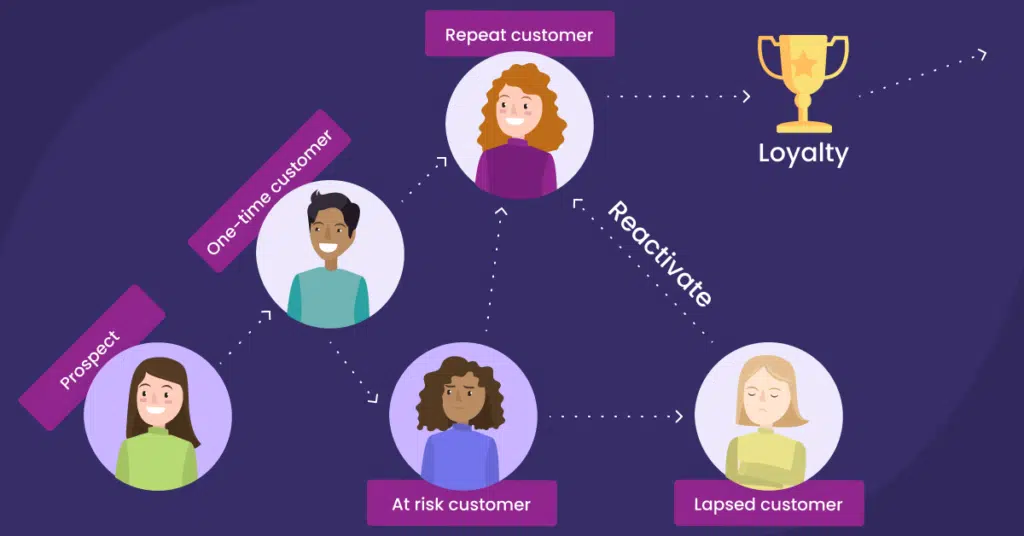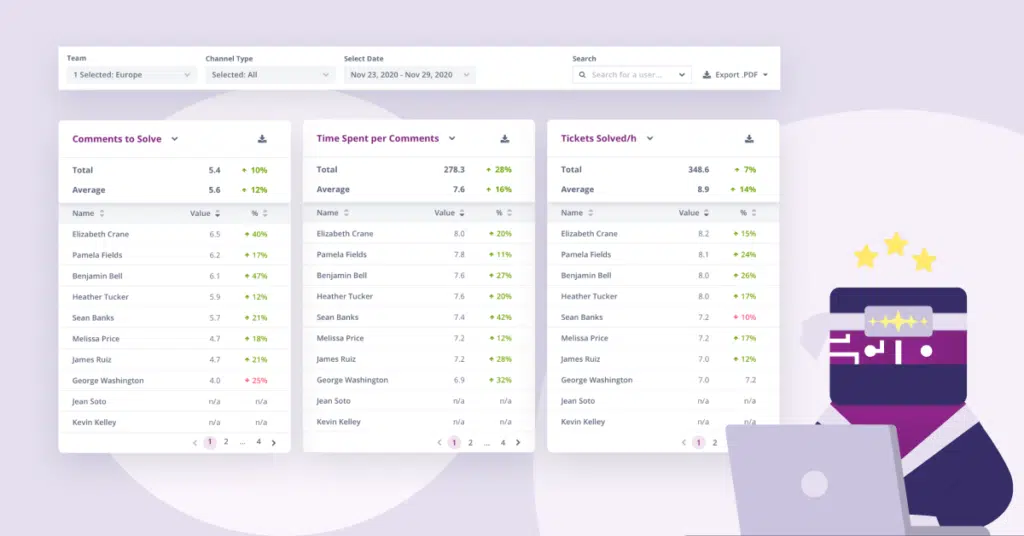If you’re refreshing your strategies to improve customer satisfaction, this is the right place for you.
You already know customer satisfaction is the most important customer service metric. In fact, excellent customer service is ranked number one when asking consumers what impacts their level of trust with a company. Trust is a critical part of any business relationship, but finding the right strategies to improve it — along with your customer satisfaction — can be challenging.
In this article, we’ll focus on methods of improving customer satisfaction and ways to understand your customers as well as how your agents are performing so you can improve your CSAT scores.
- What is customer satisfaction (CSAT)?
- The benefits of improving customer satisfaction
- 12 strategies to improve customer satisfaction
- There are two sides to improving customer satisfaction
What is customer satisfaction (CSAT)?
Customer satisfaction is a way to determine if your customers are happy with your products or services and the level of service they’ve received. Your customer satisfaction score, or CSAT, is the number one way to measure that happiness.
Your CSAT score shows real numbers that reflect your customer’s satisfaction rates. You’ll also want to look at additional customer service metrics to get the most complete picture of your customers’ satisfaction.
The benefits of improving customer satisfaction

Customer satisfaction means more than a customer saying they’re happy. It means having them tell you as well their friends and family that they’re satisfied with your product or service.
Taking steps to increase customer satisfaction provides a number of benefits. For starters, your customers’ happiness can produce an incredible amount of positive results for your team and company. This includes increased employee engagement, customer loyalty, recurring revenue, and competitive advantage.
Let’s take a look at how you can improve your CSAT in a call center where it will make a real impact.
12 strategies to improve customer satisfaction
There are many methods to improve customer satisfaction. From internal culture to understanding everything about your customers, you can monitor data to evaluate and improve your numbers.
Here, we’re breaking down seven of the top ways you can implement customer satisfaction strategies to improve CSAT scores in your business. These techniques are split into two categories: improving performance and understanding your customers.
Improve performance
Start internally before you look externally. Increasing your customer service team’s performance can be a very effective way to also increase customer satisfaction. When your employees are productive, they’re more likely to be happy with their job, work with their colleagues efficiently, and provide customers with a great experience.
A great way to achieve this is to be transparent with agents about their performance numbers and help them constantly improve by setting SMART customer service goals. You can also give consistent and constructive feedback in their employee reviews.
Here are three ways you can directly impact your CSAT by improving agent performance:
1. Create an engaging company culture
Building a productive, supportive, and team-oriented culture allows employees to feel confident in their abilities. Enabling employees to constantly improve via strategies like gamification and rewards will motivate them as well.
Training your agents to answer customers’ questions quickly and sufficiently will make both the customer and your employee happy.
A positive work environment can have a significant impact on your agents’ morale and performance. Encourage teamwork and celebrate successes regularly. Also, ensure that your agents have the tools and resources they need to do their job effectively, such as a comfortable workspace and the right equipment.
2. Setting measurable goals
Improving your customer satisfaction score (CSAT) and other metrics require the identification of key performance indicators (KPIs) and the tracking of them. For example, you and your team can identify CSAT, average resolution time, and agent reply time as your primary metrics to improve.
Use SMART goals to determine the right objectives for your agents to work toward. Make them measurable, use tools like Scorecards to track them, and be transparent. Allow your agents to know their numbers and what they can do to achieve their goals.

Once you’ve identified and tracked your metrics, you’ll be able to identify problem areas. Find and analyze patterns, anomalies, and opportunities to improve your KPIs. These results can help you discover areas you can improve agent training.
3. Monitor performance
Regularly monitoring your customer service agents’ performance can help you identify areas for improvement and ensure that they are delivering the best possible service to your customers. But how do you know what metrics to track?
One way to measure performance is by using customer satisfaction scores. Ask your customers to rate their experience after interacting with your agents, and use this feedback to identify areas for improvement. You can also track metrics like call times, first-call resolution rates, and customer retention rates to get a more comprehensive view of your agents’ effectiveness.
Once you have identified areas for improvement, provide feedback and coaching to help your agents improve their performance. Set clear expectations and goals, and work with your agents to create a plan for achieving them. Also, be sure to celebrate successes along the way to keep your agents motivated and engaged.
4. Quality assurance and feedback
Providing quality assurance (QA) and helpful feedback to your agents will give them insight into how they’re performing. You’ll want to develop a solid QA framework that helps you create an automatic feedback loop.
When creating a framework, consider questions like:
- How can I monitor agents’ communications?
- What scoring system will I use to evaluate interactions?
- What criteria can I use to analyze the data?
Once you’ve determined these answers, provide the data and results to your agents so they can work on the specific areas needed to improve their CSAT scores and other KPIs.
5. Encourage empathy
Empathy is a crucial element of providing excellent customer service. When customers contact your business, they want to feel heard and understood. Encouraging empathy among your customer service agents can help them connect with customers on a human level and provide a more positive experience.
To encourage empathy, provide your customer service agents with training that emphasizes active listening and responding with compassion. Encourage them to put themselves in the customer’s shoes, ask open-ended questions, and respond thoughtfully to customer concerns. Also, remind them that the customer is a human being, not just a ticket or case number.
One way to foster empathy is to use customer stories or case studies to help your agents understand the real-world impact of their work. When your agents can see how their actions help real people solve real problems, they are more likely to feel motivated and connected to their work.
Another way to encourage empathy is to create a culture of empathy within your organization. Emphasize the importance of empathy in all aspects of your business, from customer service to marketing to product development. Consider recognizing and rewarding employees who demonstrate exceptional empathy in their work.
Understand your customers

Now that your team is aligned and motivated, you can focus on CSAT improvements from the customer’s perspective. Use tools like active listening, direct feedback, and reviews. Then measure your customer service performance regularly.
Monitor your KPIs intently and determine where changes can be made or processes can be improved based on your results.
Here, we’ll discuss techniques you can use to understand your customers better, provide great customer service, and improve customer satisfaction:
6. Act on both positive and negative customer feedback
All the feedback you receive is extremely valuable to you and your agents — from both sides of the spectrum of positive and negative. While positive feedback helps boost confidence and motivate your agents, negative feedback provides ways to improve. You can learn a lot from this valuable feedback so thank every customer regardless of the tone.
Listen to your customers and what their needs truly are. If their complaint is that they were on hold waiting to speak with someone for 20 minutes, work to find ways to decrease that time.
Whether it’s hiring more people, offering an option to call customers back, or distributing the workload amongst current agents, helping customers faster will increase their satisfaction levels (and CSAT scores).
Another way to improve customer satisfaction is to look through reviews for trends. If you notice common issues, tag reviews to categorize them. By identifying the root of the problem, you can improve proactively before it becomes a bigger problem.
7. Provide support through the right channels
Supporting your customers in the best way for them means knowing through which channel they prefer to contact you. Depending on the number of resources and customers you have, you can position your agents to cover all the channels needed.
Consider the following questions:
- What is your customer demographic?
- What channels do your customers prefer to use: WhatsApp, live chat?
- Would your customers prefer self-service or talking to an agent?
Find out these answers and everything else about your customers that you can. This way, you’ll be able to help them in the best and most efficient ways.
8. Build self-service options: Help your customers help themselves
Some customers just want to get the answer to their question or solve their problem without having to call customer service. That’s where self-service options come in. FAQs, knowledge bases, and tutorials can all be effective ways to help your customers help themselves.
To create effective self-service options, put yourself in your customers’ shoes. What questions or problems are they most likely to encounter? Make sure your content addresses those needs and is up-to-date and organized. Use analytics to track which self-service options are most popular and improve or expand those resources accordingly.
9. Be transparent and honest: Build trust with your customers

Transparency and honesty are essential in building trust with your customers. When they trust your business, they’re more likely to stick around, recommend you to others, and leave glowing reviews. But if you’re not transparent or honest, you risk eroding that trust.
To build trust, be upfront about your products and services, pricing, and policies. Provide clear information about what your business offers, how it works, and what customers can expect. If something goes wrong, admit your mistakes, and take quick action to make it right. This not only shows your customers that you take their concerns seriously but also demonstrates your commitment to providing excellent customer service.
10. Offer incentives and rewards: Delight your customers with perks

Everybody loves a little something extra, right? Offering incentives and rewards can be an effective way to increase customer satisfaction levels and encourage repeat business. Discounts, freebies, and loyalty programs are just a few examples of incentives and rewards you can offer.
When creating your incentives and rewards program, think about what will appeal to your target audience. If you sell products that customers need to replenish regularly, consider offering a discount for subscribing to automatic refills. If you have a high-end customer base, consider offering exclusive access to events or early access to new products. You can even get creative and use gamification techniques to create fun challenges or contests that encourage customers to engage with your brand.
11. Take a human-centered approach
Understanding your customers means truly knowing what’s important to them. One of the best ways to find out is to ask them. Whether it’s on the phone, in a survey, or via live chat, you can learn a lot about a customer from what they say if you’re truly listening.
Active listening is a great way to let the customer know you’re understanding what they want and will be able to help them. This gives the customer confidence in your company and a much higher level of satisfaction.
You can also use tools on your website such as a community forum to add a peer-to-peer human element to your customer satisfaction strategy. This way, customers can look up questions other people have already asked and answered and you can also get a pulse on the types of questions customers ask. Frequently asked questions can get added as articles to your support center, and letting customers answer each other’s questions can also reduce the creation of customer service tickets.
12. Proactively measure your customers’ satisfaction
An important aspect of customer satisfaction is to know exactly how happy your customers are. The best (only true) way to know this is to measure it regularly. There are a number of customer satisfaction metrics to measure, but your CSAT score is the most important one.
You’ll decide what other KPIs to measure proactively, but CSAT improvement should be your top priority. To improve your CSAT, you’ll first need to identify how you’ll measure customer satisfaction.
For example, ask your customers to scale their happiness with your product or service from 1-7, seven being the highest. If your customer scores your service over five, these can be (and usually are) your most satisfied customers.
You can also look at the scores below three and identify what challenges those customers faced so you can improve in the future. Be aware, unsatisfied or neutral customers are far less likely to respond to surveys which may skew the results.
Your agents can also be proactive by contacting your customers before they need to contact your support team. Train your agents to send text reminders or emails to customers about the product or service they purchased.
Encouraging agents to call customers about issues (before they call you) is another way to actively boost customer satisfaction. Allocate resources appropriately, of course, but finding time to make this extra effort will skyrocket your CSAT.
There are two sides to improving customer satisfaction
There is more than one side to the customer satisfaction equation. The key to improving customer satisfaction is a healthy balance between understanding and improving performance internally while doing the same with customers externally.
With Kaizo, a workforce engagement management platform, you can calculate these measurements easily and automatically to save you time and stress. Before you improve your customer satisfaction, you need to know the best way to measure it, along with other essential metrics.



